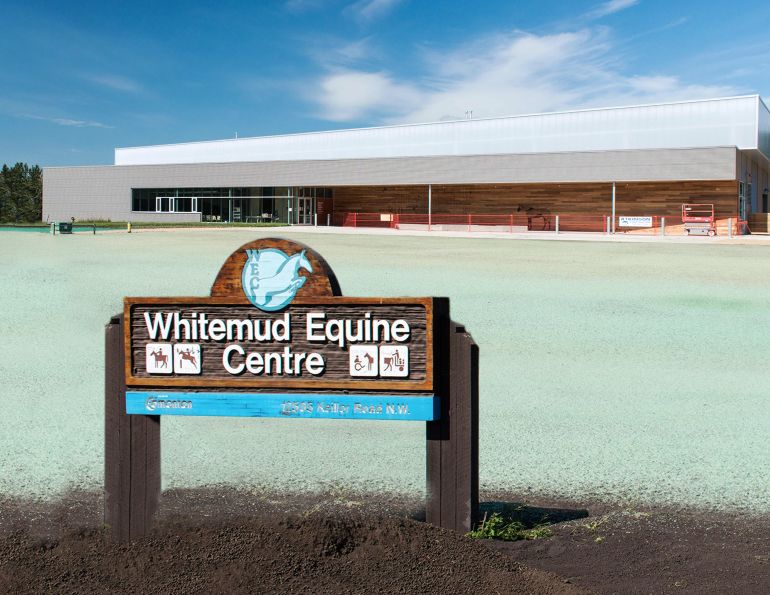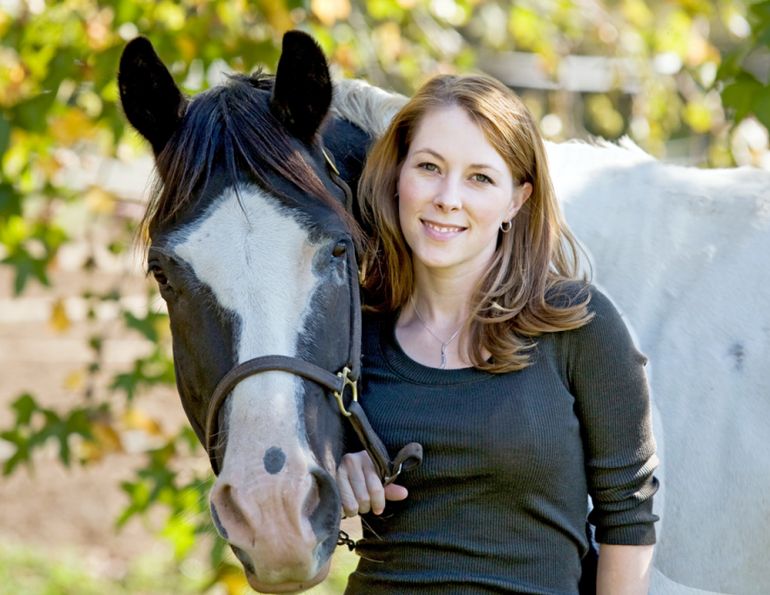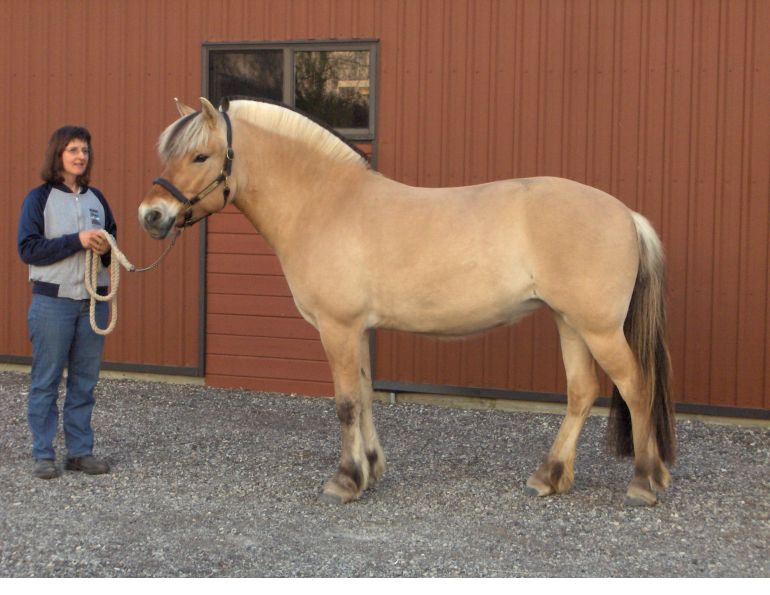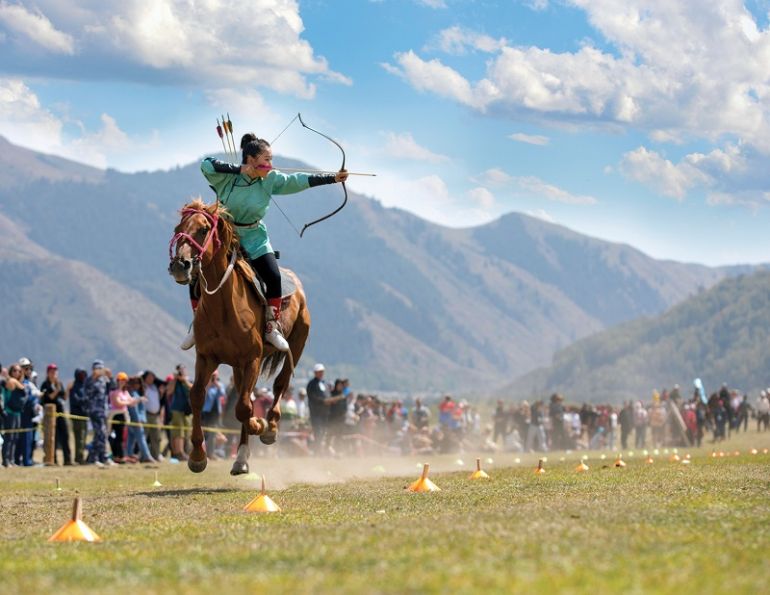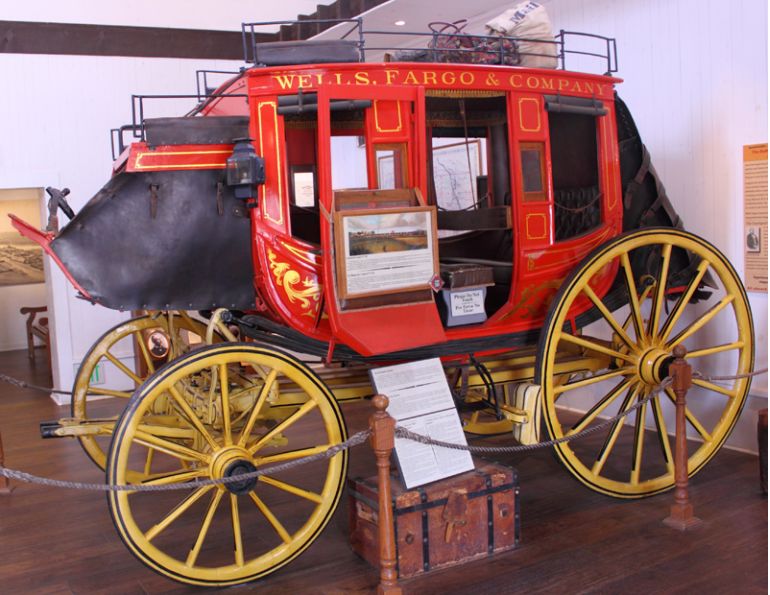By Margaret Evans
In March 2012, Titus and Amaro almost got put out to pasture. Not that they would have minded some downtime chowing on prairie spring grass. But the folks in Winnipeg howled in dismay. No way should these two beloved black Percheron/Thoroughbred crosses leave the city streets.
You see, Titus and Amaro are the faces of the Winnipeg Police Service’s Mounted Patrol Unit. Earlier this year, the unit was slated to be disbanded along with fall recruitment and the purchase of some motorcycles as part of a cost cutting measure to shave one million dollars off the budget.
Not so fast, responded Winnipeg residents and business owners alike, who saw in the horses the most popular community relations image of their police service. As a result of this swift push-back, the Winnipeg Police Service reconsidered its plans and decided that their mounted unit would ride the streets for at least another year.
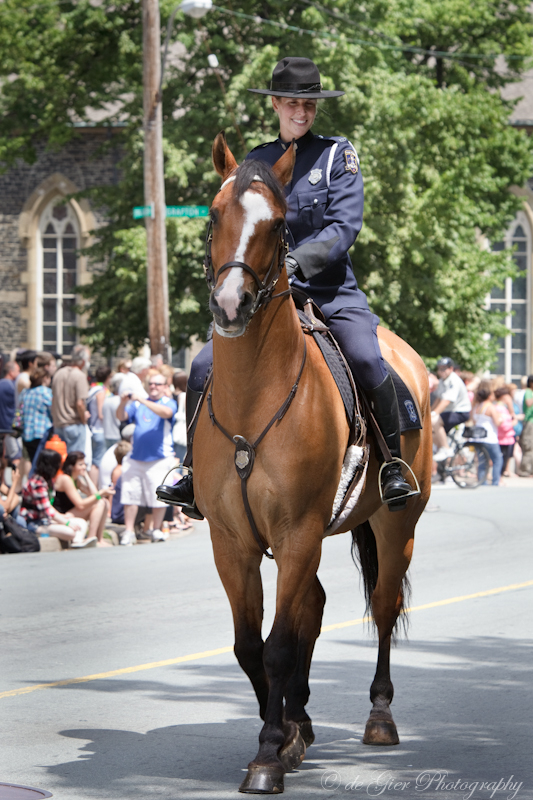
Photo courtesy of Sergeant Julie Cecchetto, Halifax Regional Police, Mounted UnitPolice horses such as Cruise, ridden by Diane Woodward of the Halifax Regional Police Mounted Unit, act as ambassadors for the police by improving relations with the community.
What is it about police horses that continues to draw people to stroke noses and ask questions? From Vancouver to Halifax, police horses draw the public like a magnet. Their high profile presence never fails to draw admiration, whether at festivals and special occasions, in parades, or when accompanying visiting dignitaries and doing crowd control.
But preparing a suitable horse for work on the streets takes time and specialized training. Once a horse has been purchased, training starts with basic flat work and conditioning. Depending on time, budget, and resources, training can be anywhere from, literally, on the job training (as with the Halifax mounted unit) to a period of 12 to 18 months’ duration (as with the Toronto and Calgary mounted units).
As the horse progresses, specialty training is introduced to teach the horse how to cope with stressful situations such as smoke, loud noises, gunfire, and hostile crowds. Police horses need to be able to respond directly to the rider, cope with sudden unexpected situations, and behave in a reliable way for the safety of the rider and the public alike.
The qualities of an ideal police horse are very similar coast to coast. They are mostly draft crosses on the tall side at 16 to 17 hands, and all have steady temperaments with a willingness to work and to please.
“When we are looking to purchase new horses generally we look for draft cross horses that are at least 16 hands and have an even temper and calm personality,” said Sergeant Doug McMillan with the Vancouver Police Department’s Mounted Unit. “We bring the prospective horse in for a sixty day trial period to assess the horse’s personality and temperament for police work (then) a recommendation to purchase is made or the horse is returned.”
“We just purchased two Percheron horses (Turbo and London) that are eight years old and half-brothers,” said McMillan. “These two horses have been previously ridden by many different people including kids. They are both very engaging and curious horses with a real interest in people and their surroundings. They have quickly progressed through the training in the five months that they have been here.”
Vancouver’s Mounted Unit consists of 13 horses, 10 of which are currently being used by members, and is responsible for policing over 1000 acres of Stanley Park and the park’s 125 miles of roads and trails, as well as areas in the downtown core. The unit was part of the escort for the Olympic torch during its historic relay and was very effective during the protests that occurred during the 2010 Olympic Winter Games.
Halfway across the country, the criteria for police horses in Toronto is much the same as in Vancouver.
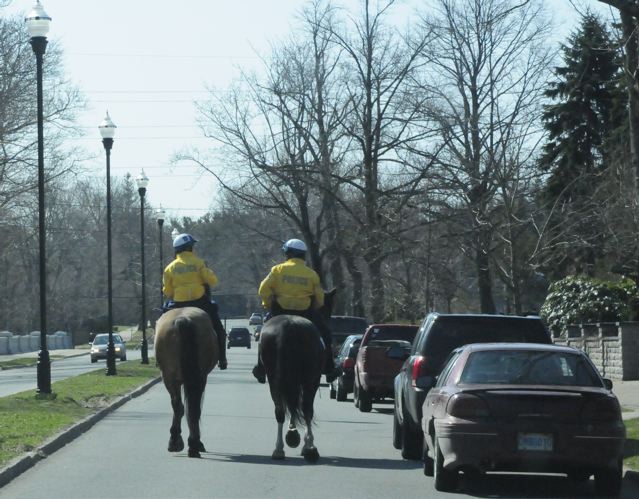
Police horses are trained to cope with such stresses as traffic, smoke, loud noises, gunfire, and hostile crowds. Photo: courtesy of Sergeant Julie Cecchetto, Halifax Regional Police, Mounted Unit.
“We presently have 27 horses in our unit,” said Staff Sergeant Graham Queen with the Toronto Police Service. “Our preferred breed is the Percheron cross. Our horses generally range from 16 to 18 hands. We try and choose bold horses that can work through various environmental conditions, i.e., noise, weather, smoke, hostile crowds, etc. Our main functions include crowd management, operational support to policing divisions, search for missing persons, public relations at community events, parades, funerals, and ceremonies, high profile events such as the Queen’s Plate, the G-20, and the Caribana (street festival) and general patrol on horseback.”
Horses with the Toronto Police Service carry names with historical significance, such as Tecumseh who is named after a Shawnee Chief who fought and died in the War of 1812.
“Tecumseh is our representative at many native functions in Toronto,” said Queen. “The name is a good fit as he is an earthen colour and is a solid horse that stands proud. He looks very regal with his specially made native saddle blanket.”

Greg John on Vimy Ridge at a recent Remembrance Day memorial. Photo: Anne de Hass, courtesy of Toronto Police Service Mounted Unit.
Another horse with the Toronto Police Service, Vimy Ridge, was named in honour of the famous battle in Vimy, France, during the First World War.
“[He] attends all of the ceremonies held during the Easter weekend,” Queen said. “Vimy, as we call him, is a large black horse with a very ‘Canadian’ type personality. He is both gentle and driven to complete a task.”
Tasks assigned to police horses in Calgary include public relations work, patrolling streets and pathways, and conducting search operations. The Calgary Police Mounted Unit has four Canadian horses and two Quarter Horses.
“All our horses are at least 16 hands high, geldings, and of a calm, quiet nature,” said Constable Dave Hagedorn. “Two of our horses with unique personalities that come to mind are our two new Canadian horses, Rio and Stryder. Rio is a seven-year-old black with a stubborn streak. He is generally brave and good natured, but he will stand his ground when confronted with new situations. Stryder is dressage trained and a very fluid mover. He is a very nice looking horse with fine features and is a little more flighty than Rio, but the more he sees the better he is.”
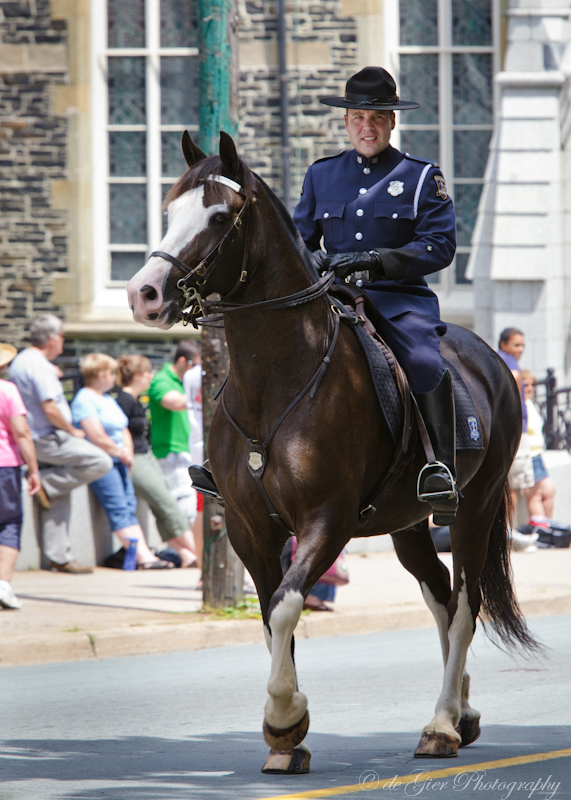
This ideal police horse type is exemplified by Sarge, a 16.3 hand, Clydesdale/Thoroughbred gelding ridden by Chris Marinelli with the Halifax Regional Police Mounted Unit. Photo courtesy of Sergeant Julie Cecchetto, Halifax Regional Police, Mounted Unit
On the east coast, two horses comprise the Mounted Unit of the Halifax Regional Police.
“Sarge is a 16.3 hand high, dark bay (almost black) horse with four white socks and a white face,” said Sergeant Julie Cecchetto. “He is a Clydesdale/Thoroughbred cross.”
“Cruise is a 17.2 hand high bay, with a narrow blaze,” Cecchetto continued. “He is a Percheron/Quarter Horse cross. Both of our horses are from New Brunswick but originally they were from the PMU farms in Western Canada. Historically, we have gone for a draft cross gelding. We like them to be over 16 hands high, sturdy build, with a very quiet, friendly personality. They should be especially good with kids.”
As Cecchetto explained, horses that are people friendly are well suited to police work. Sarge was raised on a hobby farm that was also home to special needs people so he was well accustomed to lots of pats. On the street, police mounts are approached all day to be photographed and petted by people unfamiliar with horses. But when unruly crowd situations erupt, they have to be ready to move immediately into action.
“While patrolling a very busy intersection of Halifax called the ‘Pizza Corner,’ Sarge’s zippy side comes out,” Cecchetto said. “This intersection becomes filled with late night partiers as the bars let out at about 3:30 am. They don’t stay on the sidewalks and therefore block up the streets, causing traffic jams and a hazard for intoxicated pedestrians. Sarge is used to side-pass up the street along the sidewalk, moving people back onto the sidewalks and allowing the traffic to move.”
Cecchetto said that 75 percent of their work is proactive patrol, especially in at-risk neighbourhoods where mounted constables can interact with citizens and gain intelligence on local criminal activity. This is likely similar to the work of other mounted units across Canada.
“We split our time with the horses between operational duties including patrol, and ceremonial duties including parades and special events,” said Hagedorn in Calgary. “We generally use the horses during parades as parade marshalls. However, we were in one parade that was deemed somewhat controversial in some peoples’ eyes. We had a fight break out between a bystander and a person in the parade. It basically shut down the last part of the parade. We used the horses to extract both parties and held them against a vehicle with both horses leaning into them while a marked unit attended for back up.”
Sudden and inflammatory situations are exactly what police horses are trained for and excel at.
“There is no better example of the value of the horses and the Mounted Unit than what was demonstrated during the 2011 Stanley Cup Riot,” said McMillan in Vancouver. “The Mounted Unit played a pivotal role in quelling the riots. I was not the Sergeant in the unit during the riots but I was on the ground and observed the Mounted Unit in action. At the beginning of the riot, members of the Public Order Unit and regular patrol officers were faced with a very violent crowd of at least 50,000 in the area around the Vancouver Public Library. The members could not advance on the crowd without being pelted with debris including bottles, glass, and pieces of asphalt. The Mounted Unit arrived and within minutes had driven the crowd back, allowing the Public Order Unit to take control of the intersection. The Mounted Unit continued throughout the night attending to all the areas where the rioting was continuing. The horses were not deterred by the fires, or the tear gas, or the violent crowd that was not above striking and throwing debris at the horses and the members. The riot would have continued on for many more hours than it did had it not been for the work of the Mounted Unit.”
During the riot, staff with the London Drugs at Granville and Georgia streets were forced to hide in a reinforced steel room in the store as it was ransacked and looted. Some $650,000 in damage was done. In gratitude for the work of the police and the Mounted Unit, employees raised $7000 for the Vancouver Police Foundation, part of which went toward the purchase of Turbo and London.
“In addition [to the London Drugs’ donation], citizens sent cards and letters, carrots and treats for the horses out of appreciation,” said McMillan.
Across Canada, people are supportive of horses even if they may never have any connection with them.
“The public in Calgary is very supportive of the horses, as the city was built on the livestock industry,” said Hagedorn. “Calgary has managed to maintain a mounted unit since 1978.”
“The public reaction to the horses is fantastic,” stressed McMillan.
No matter where they serve, police horses take centre stage.
“I believe the greatest value of our horses is their ability to provide such wide ranging services,” said Queen. “One day we can be engaged with a hostile protest group, the next we can be at Sick Kid’s Hospital making an ill child’s day a little more pleasant, the next we can be escorting a full police funeral for a fallen colleague. This is probably the reason why mounted officers want to stay in this line of work for so long.”
As municipalities look for ways to tighten budgets and save costs, the contribution made by the horses of the mounted units must be carefully evaluated. From community relations, to crowd control on the mean streets of our largest cities, the horses that serve and protect remind us every day that their value goes well beyond mere dollars and cents.
Main photo: Anne de Hass, courtesy of Toronto Police Service Mounted Unit - Vimy Ridge, ridden by Greg John, is one of 27 horses currently in the Toronto Police Service Mounted Unit. Here, members of the unit are dressed in World War 1 uniforms.








